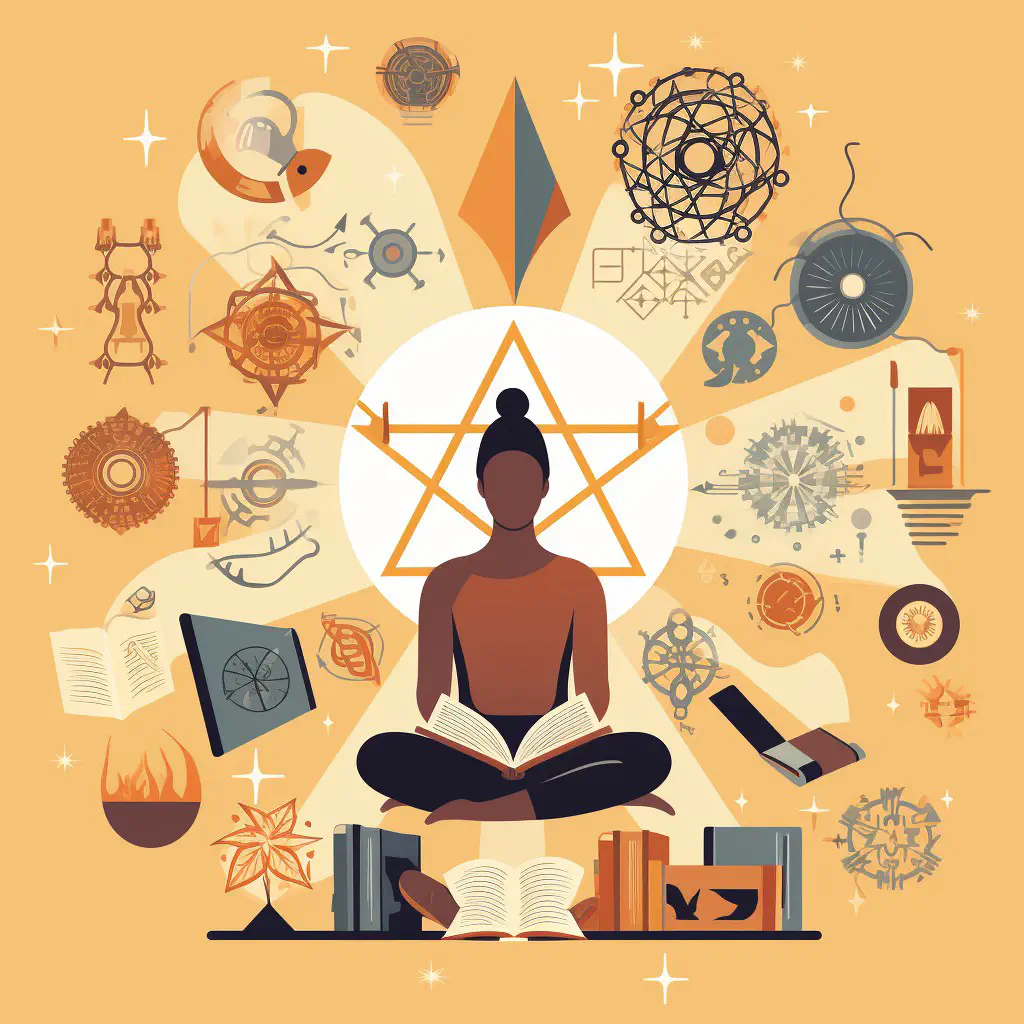
Introduction
An open thinking mindset is the ability to approach new and challenging situations with a positive, curious attitude that fosters learning and growth. It involves being open to new ideas, diverse perspectives, and different ways of thinking. Developing an open thinking mindset is important because it allows us to adapt to change, avoid being stuck in a fixed mindset, and allows us to see opportunities where others might not.
The following step-by-step guide provides a roadmap for developing an open thinking mindset. Each step is designed to help you identify and overcome biases, challenge assumptions, seek out diverse perspectives, practice empathy, embrace uncertainty, and encourage creative thinking. By following these steps, you can develop the skills and habits necessary to approach every experience with an open mind and the flexibility to respond in the most effective way possible.
So let’s get started on this exciting journey towards open thinking!
Step 1: Recognize your biases
Biases are deeply ingrained beliefs and prejudices that affect our judgement and decision-making processes. They can come from personal experiences, cultural upbringing, or even media influences. It’s essential to recognize our biases to develop an open thinking mindset.
Explanation of biases
Biases can be categorized into three types:
- Cognitive biases are the unconscious errors in our thinking process that affect our decision-making abilities.
- Cultural biases stem from our cultural upbringing and the societal norms we grow up with.
- Personal biases are formed through personal experiences and influence our opinions and beliefs.
How biases affect our thinking
Our biases affect how we perceive and interpret information, leading to inaccurate conclusions or judgments. Our biases can lead us to stereotype people, ideas, and beliefs, and close our minds to other viewpoints or perspectives. Recognizing and acknowledging our biases is the first step in overcoming them.
Methods to recognize biases
Here are some methods to recognize our biases:
- Self-reflection: Take a moment to think about your opinions and beliefs. What experiences have led you to those beliefs? Are there any assumptions that you are making? Are there any sources of information that you are relying on heavily?
- Seek feedback: Ask trusted individuals for their feedback on your decision-making processes and thought patterns. Listen to their perspective without becoming defensive.
- Use checklists: There are various checklists available online that can help identify specific types of biases. Use them as a tool to recognize the specific biases you may have.
Recognizing our biases is the starting point towards developing an open thinking mindset. In the next step, we will discuss how to challenge our assumptions to further open up our minds.
Step 2: Challenge your assumptions
Assumptions are the things we take for granted as facts without questioning them. They are one of the common roadblocks to open thinking. Subconsciously, our assumptions steer the way we think and make decisions, leading us to miss out on alternative perspectives and fresh ideas. Therefore, challenging your assumptions is a crucial step towards developing an open thinking mindset.
Explanation of assumptions
Assumptions are our underlying beliefs about a situation, person, or thing. They form based on our experiences, past events, cultural background, and upbringing and help us make sense of the world around us. Assumptions come in different forms, such as cultural assumptions, personal assumptions, and professional assumptions.
How assumptions affect our thinking
While assumptions are useful shortcuts in our decision-making processes, they can also hinder our ability to think openly. When assumptions go unchallenged, they restrict our perspective, filter out new information, and create cognitive biases. Assumptions are often based on incomplete or inaccurate information or are no longer applicable to the current situation.
Methods to challenge assumptions
To challenge your assumptions effectively, you need to be aware of them and willing to question them. Here are some methods to consider:
-
Re-evaluate the evidence: Examine the evidence and facts that led to your assumption. Are they still relevant and accurate in the current context? Is there any new evidence that contradicts your assumption?
-
Seek out diverse perspectives: Consult with individuals who hold different perspectives or have different ideas about the situation. They may provide insights that challenge your assumptions.
-
Use the 5 Whys: Ask yourself “why” five times in a row to dig deeper into the belief and challenge what’s behind the assumption.
-
Play devil’s advocate: Assume the opposite of what you believe and try to make it work. By doing so, you can identify the gaps in your assumptions and potentially fill them.
By challenging your assumptions, you open yourself to new ideas and perspectives and develop critical thinking skills. When you challenge your assumptions, you are more likely to make informed and accurate decisions.
Step 3: Seek out diverse perspectives
Seeking out diverse perspectives involves deliberately exposing oneself to a wide range of opinions, beliefs, and perspectives that are different from our own. This step is an essential aspect of developing an open thinking mindset since it enables us to broaden our understanding of the world, appreciate different viewpoints, and challenge our beliefs and assumptions.
Explanation of diverse perspectives
Diverse perspectives are the many different viewpoints that exist in the world. They are shaped by factors such as culture, ethnicity, gender, age, religion, education, and experiences. Gaining exposure to diverse perspectives helps us understand and appreciate different beliefs, customs, and practices, which can ultimately lead to greater empathy and understanding towards others.
Why seeking out diverse perspectives is important
Developing an open thinking mindset requires us to challenge our own beliefs and engage with different viewpoints. Seeking out diverse perspectives is essential for this process since it broadens our understanding of the world and different worldviews. Additionally, it encourages us to be more curious, open-minded, and empathetic towards others, which can ultimately enhance communication, creativity, and problem-solving.
Methods to seek out diverse perspectives
Here are some practical methods to seek out diverse perspectives:
-
Expand your reading list: Incorporate books, articles, and blogs that represent a diverse range of writers and perspectives.
-
Attend events and conferences: Attend conferences, workshops, or community events where you can engage with people from different backgrounds and expand your network.
-
Embrace diversity in your community: Engage with people from diverse backgrounds within your own community by participating in cultural or local events.
-
Seek out media from different sources: Read or watch news and media from different sources to gain a broader understanding of issues as opposed to just one-sided viewpoints.
Overall, seeking diverse perspectives can help you broaden your perspectives, challenge your beliefs, and become more receptive to others’ opinions. It’s an essential aspect of developing an open thinking mindset.
Step 4: Practice empathy
Empathy is the ability to understand and share someone else’s feelings or experiences. By practicing empathy, we can develop a deeper understanding of others and gain a broader perspective, which is crucial to developing an open thinking mindset. Here are some methods to practice empathy:
Listen actively
Listening actively involves paying attention to what someone is saying without interrupting or judging. Engage with the speaker by asking open-ended questions and clarifying points to ensure you understand their perspective.
“Most people do not listen with the intent to understand; they listen with the intent to reply.” - Stephen Covey
Be present in the moment
Practicing empathy involves being fully present in the moment. Try to put aside any distractions such as your phone or other tasks and focus your energy on the person you are interacting with.
“Empathy is simply listening, holding space, withholding judgment, emotionally connecting, and communicating that incredibly healing message of ‘you’re not alone’.” - Brene Brown
Practice self-reflection
Being able to empathize with others starts with being able to understand and manage your own emotions. Take time for self-reflection and become aware of how your own biases and experiences may influence your interactions with others.
“The willingness to reflect on one’s own experience, and to constantly learn from it, is one of the strongest predictors of one’s future success.” - Adam Grant
Step out of your comfort zone
Actively seek out opportunities to interact with people from diverse backgrounds and experiences. Embrace differences and be open to learning from others, even if their opinions or beliefs differ from your own.
“The biggest adventure you can ever take is to live the life of your dreams.” - Oprah Winfrey
By practicing empathy, we can develop a greater understanding of others and enhance our ability to think openly and critically. As we become more aware of how our own biases and experiences influence our interactions with others, we can begin to break down barriers and build stronger connections with those around us.
Step 5: Embrace uncertainty
Uncertainty is a constant in life, and it can often lead to anxiety and fear. However, embracing uncertainty is essential to developing an open thinking mindset. Uncertainty opens us up to new possibilities and allows us to be more receptive to diverse perspectives.
Explanation of uncertainty
Uncertainty refers to situations where outcomes are unpredictable or unknown. It can be caused by a lack of information, unpredictability of events, or a changing environment. Uncertainty can make us feel uncomfortable or even afraid, as it challenges our sense of control and stability.
How embracing uncertainty helps develop an open thinking mindset
Embracing uncertainty requires us to tolerate ambiguity and discomfort. Doing so can lead us to be more curious and open to new experiences, ideas, and people. Embracing uncertainty allows us to be more flexible and adaptable in our thinking, which is critical for developing an open thinking mindset.
Methods to embrace uncertainty
Here are some methods to help you embrace uncertainty:
- Practice mindfulness: Mindfulness helps us become more aware of our thoughts and emotions, enabling us to approach uncertainty with a clearer and more accepting mindset.
- Exercise curiosity: Cultivate a sense of curiosity about the unknown. Instead of fearing it, approach it with a sense of wonder and interest. Ask questions and seek out new information.
- Learn to tolerate discomfort: We often avoid uncertainty because it makes us uncomfortable, but tolerating discomfort is necessary for growth. Practice sitting with discomfort and notice how your body reacts.
- Take small risks: Embracing uncertainty means taking risks. Start with small steps, like trying a new hobby or reaching out to someone with a different perspective.
- Cultivate resilience: Resilience allows us to bounce back from setbacks and adapt to change. Develop resilience by learning from failures, accepting change, and focusing on the positive.
By embracing uncertainty, you can develop an open thinking mindset that allows you to approach situations with curiosity and adaptability. Remember, uncertainty is not synonymous with danger; it can lead to growth and new opportunities.
Step 6: Encourage Creative Thinking
Creative thinking is an important aspect of developing an open thinking mindset. It involves generating ideas that are original, useful, and valuable. Creative thinking allows us to solve problems in innovative ways, come up with new ideas, and make connections between seemingly unrelated concepts. Here are some methods to encourage creative thinking:
Brainstorming
Brainstorming is a popular method used to generate ideas. It involves coming up with as many ideas as possible, without evaluating them. The goal is to generate a large number of ideas, which can then be evaluated later. To encourage creative thinking while brainstorming, it’s important to:
- Encourage wild ideas: No idea is too crazy or too outlandish. Wild ideas can often lead to innovative solutions.
- Build on others’ ideas: One idea can spark another. Encourage participants to build on each other’s ideas to generate even more possibilities.
- Suspend judgment: Do not criticize or evaluate ideas during brainstorming. Judgment can stifle creativity.
Mind Mapping
Mind mapping is a visual method used to generate and organize ideas. It involves creating a map of a central idea and then branching out to related ideas. Mind mapping can be a helpful tool for encouraging creative thinking because it allows for a large number of ideas to be generated quickly. To encourage creative thinking when mind mapping, it’s important to:
- Allow for free association: Ideas do not have to be related to the central idea. Let participants make connections freely.
- Use symbols and images: Symbols and images can help to stimulate creativity and spark new connections between ideas.
- Make connections: Encourage participants to make connections between seemingly unrelated ideas to generate innovative solutions.
Reverse Thinking
Reverse thinking involves looking at a problem or challenge from a different perspective. Instead of looking at what needs to be done to solve the problem, think about what could be done to make the problem worse. This can help to generate creative solutions that might not have been considered otherwise. To encourage creative thinking using reverse thinking, it’s important to:
- Challenge assumptions: Reverse thinking requires looking at a problem from a different angle. Challenge assumptions to generate new perspectives.
- Let loose: Reverse thinking is a fun exercise. Encourage participants to let loose and be silly to generate even more wild ideas.
- Evaluate ideas: Once a list of ideas has been generated, evaluate them to find the most creative and innovative solutions.
By incorporating these methods into your thinking process, you can encourage creative thinking and develop an open thinking mindset. Remember, creative thinking is not just about generating new ideas, but about evaluating and implementing those ideas as well.
Conclusion
In conclusion, developing an open thinking mindset is critical for personal growth and success. By recognizing our biases, challenging our assumptions, seeking out diverse perspectives, practicing empathy, embracing uncertainty, and encouraging creative thinking, we can expand our minds and become more open to new ideas and experiences.
It’s essential to keep in mind that developing an open thinking mindset is not a one-time task but a continuous process. We must be open to learning and adapting as we encounter new situations and information.
In a world that is becoming increasingly diverse and complex, developing an open thinking mindset can help us navigate through uncertain times. With an open mind, we can approach challenges more creatively, work collaboratively, and lead with empathy.
Our hope is that this guide has provided you with practical tools and strategies to cultivate an open thinking mindset. We encourage you to continue learning and exploring, seeking out new ideas and perspectives, and challenging yourself to think differently.
As Albert Einstein once said, “The measure of intelligence is the ability to change.” By embracing an open thinking mindset, we can continuously learn, grow, and make a positive impact on the world around us.
References
- Brown, B. (2019). Dare to Lead: Brave Work. Tough Conversations. Whole Hearts. Random House Business Books.
- Du, H., & Wylie, A. (2016). A cultural-educational model for developing global competence. Journal of Studies in International Education, 20(4), 307-329.
- Tippett, K. (2016). Becoming Wise: An Inquiry into the Mystery and Art of Living. Penguin Press.
References
- Brown, B. (2015). Rising strong. Random House.
- Galinsky, A. D., Maddux, W. W., Gilin, D., & White, J. B. (2008). Why it pays to get inside the head of your opponent: The differential effects of perspective taking and empathy in negotiations. Psychological science, 19(4), 378-384.
- Kahneman, D. (2011). Thinking, fast and slow. Macmillan.
- Langer, E. J. (1997). The power of mindful learning. Da Capo Press.
- Tversky, A., & Kahneman, D. (1974). Judgment under uncertainty: Heuristics and biases. Science, 185(4157), 1124-1131.

